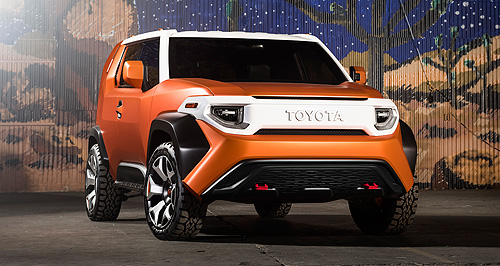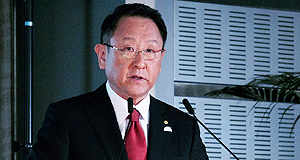Make / Model Search
News - ToyotaToyota’s new platform signals end of boring designStyle and substance: Thanks to the Toyota New Global Architecture (TNGA) platform, the Japanese brand will be able to develop vehicles that both look and drive dynamically. Style now a higher priority for future Toyota product as more vehicles move to TNGA11 May 2018 By TUNG NGUYEN TOYOTA’S New Global Architecture (TNGA) platform will unlock bolder and more dynamic vehicle aesthetics as the Japanese car-maker shifts away from the boring, sensible and safe models of its past.
Spearheading the wave of fresh Toyota product will be the brand’s California-based Calty Design Research studio, which had a hand in crafting the mould-breaking C-HR small SUV launched last year, the Supra-previewing FT-1 concept from the 2014 Detroit motor show and the Lexus LC luxury sports coupe.
In Australia to talk to local media about the design process, Calty Design Research president Kevin Hunter said the aesthetics of new models is now taking a higher priority than before.
“In the past at Toyota – and this is another reason why we had rather bland design – the design group was basically being handed an engineering package and saying ‘hey, make a beautiful car’.
“Well, first we need good stance, we need good front overhang, rear overhang, height – we need all these proportions working in harmony together before we can really achieve good design.
“So now at the very early stage, design is involved with engineering, and we’re working through these problems together and trying to find the best solution.
“Design has a much stronger seat at the table now within Toyota’s organisation and this is contributing a lot to the bottom line, which is getting more dynamic-looking automobiles.”
First introduced in 2015 with the fourth-generation Prius hybrid, versions of the TNGA modular platform now underpin the C-HR, Camry, upcoming Corolla, Lexus UX crossover, Lexus LS sedan and new-generation RAV4, as well as being rumoured as the basis of the all-new Kluger large SUV.
Mr Hunter revealed that the TNGA platform plays a crucial role in shaping more aesthetically pleasing vehicles in-line with the architecture’s strong dynamic characteristics.
“These new models are pathfinders for the styling and dynamic benefits of TNGA, qualities that will be further developed as new platforms and vehicles are introduced to Toyota’s global range in the months and years to come,” he said.
“TNGA has redefined Toyota’s approach to vehicle development and manufacturing, resulting in vehicles that can inspire confidence and deliver genuine fun-to-drive performance.
“The lower centre of gravity, more rigid frame, new suspension and greater use of high-strength steel provide direct benefits that result in balanced handling and a more engaging drive.
“TNGA also liberates vehicle design, enabling rooflines and bonnets to be lower and resulting in each model being visually distinctive with more appealing proportions.”
The new directive of “no more boring cars” has come straight from the top, according to Mr Hunter, with Toyota Motor Corporation president Akio Toyoda himself mandating the shift away from ‘safe’ designs.
“To get that support at the top is paramount, if we’re proposing to mix things up … if you’re not getting that support from the top, it’s not going to go anywhere and it’s going to stall out,” he said. “So having that is so critical to where we’re heading to right now.
“And the other part is getting everybody on board to think the same way. We all have to share a common understanding of where we’re heading and that has to not only be design – design is only one component of the entire process, engineering has to kick in, sales has to kick in, marketing has to, everybody has to be on board with this proposition.
“As a result of this new global commitment, we expect to develop the most capable, most exciting generation of vehicles the company has ever produced.”
Mr Hunter chalked the “bland” vehicle designs of Toyotas in the past decade to “trying to please everybody”, and as a result producing nondescript products.
“We were making really, really good cars, people liked our cars, but they were pretty bland – let’s face it,” he said.
“The next question you might be wondering is ‘well why are you making boring cars, how did that happen?’
“There’s probably many reasons … but for me, two key fundamental points are, one, we were trying to please everybody, we wanted to literally make everybody happy and not have one person disappointed in a Toyota car, but the problem is that if we try to do that … we end up in the middle and we just made vanilla cars – (but) really, really good vanilla cars.
“The other issue … is that we had a large consensus-driven organisation, and the more people you get together trying to satisfy everybody’s thoughts and opinions, again, you have to move to the middle.
“We streamlined that process and we’re making more dynamic cars, more bold cars, more pure cars and cars that we think people will really, really enjoy driving as well, and driver engagement is another big factor that’s playing into Toyota’s future direction.
“We have a good trajectory now of where we’re heading and we really feel good about it.”
The C-HR has already been heralded as a brand perception changer for the big T brand thanks to its striking design, while the Camry mid-sizer has also played a hand in moving Toyota away from uninspired styling.
Incoming models such as the Corolla small car and flagship Supra sportcar are also set to contribute to bringing dynamism back to Toyota.
 Read more10th of May 2018  Toyota’s focus on cost pays dividendsFalling sales, but Toyota profit rises on cost cutting and Forex win18th of April 2018  Driven: Toyota lobs new HiLux flagship trioToyota adds Rogue, Rugged, Rugged X variants to HiLux range, from $54,990 BOCs2nd of April 2018  Toyota Australia offers peek into local design studioAltona plant closure poses no threat to local Toyota product design and engineering28th of March 2018  New York show: All change for Toyota RAV4Toyota RAV4 to get hybrid, new 2.5-litre engine and new platform for 2019 |
Click to shareToyota articlesResearch Toyota Motor industry news |











Facebook Twitter Instagram